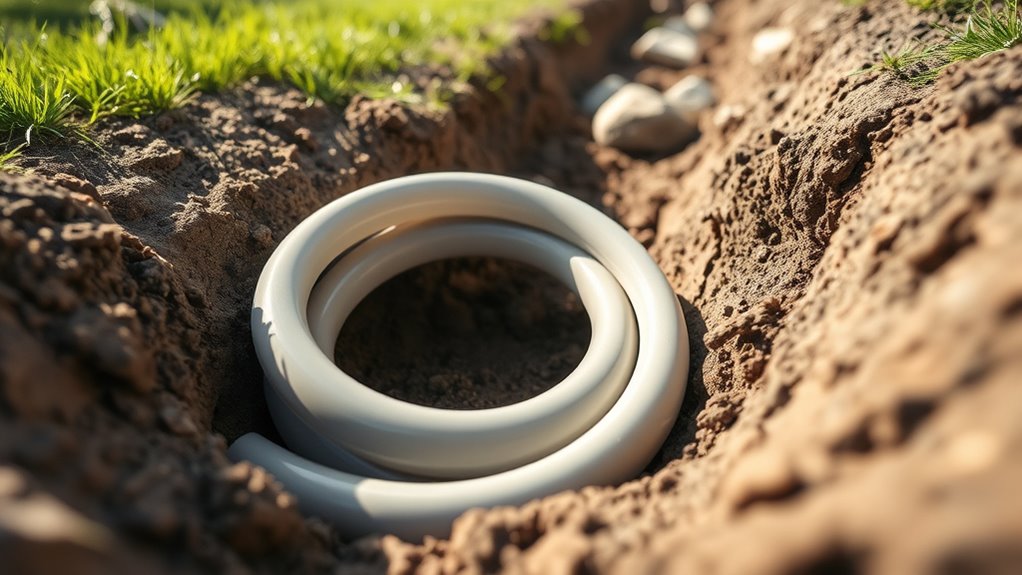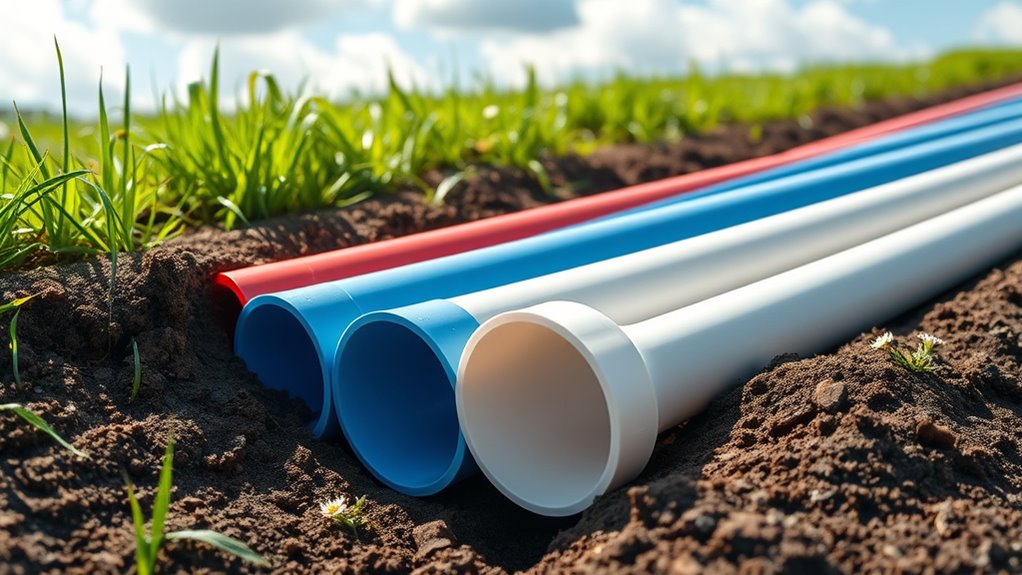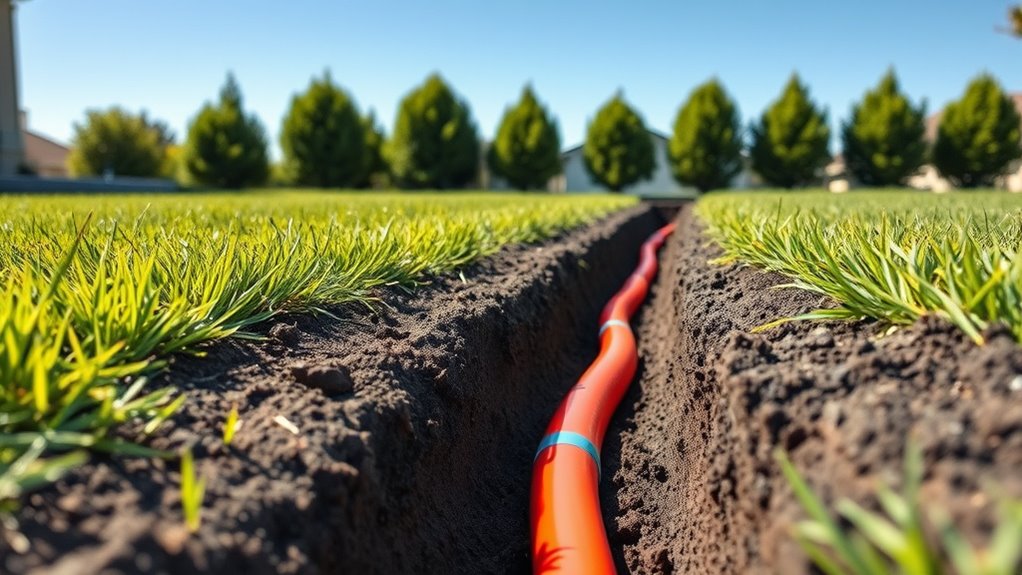Yes, PEX pipe can be buried underground, but it’s essential to follow local building codes regarding burial depth and protective measures. This type of pipe offers advantages like flexibility and corrosion resistance, but risks include damage from soil movement and chemical exposure. Regular maintenance checks are crucial for ensuring long-term durability. Make sure to choose the correct type of PEX for your specific application to ensure successful installation.
Understanding PEX Pipe and Its Applications

PEX pipe, or cross-linked polyethylene, is an ideal choice for plumbing and heating due to its flexibility, corrosion resistance, and ease of installation.
It is lightweight, making it manageable for both professionals and DIY enthusiasts. Common applications include water supply lines, radiant floor heating, and hydronic heating systems.
PEX can expand and contract with temperature changes, preventing cracking unlike traditional materials such as copper or PVC. Moreover, many installations do not require joint fittings, minimizing potential leak points.
Its versatility and durability make PEX a strong option for both residential and commercial plumbing needs.
Benefits of Using PEX Pipe for Underground Installation
Using PEX pipe for underground installation provides key benefits that meet your needs for a reliable plumbing solution.
Its flexibility and durability mean it can handle environmental stresses without compromising its integrity over time.
Moreover, PEX’s resistance to corrosion makes it an excellent choice for underground applications, ensuring long-lasting performance.
If you’re seeking a dependable option for underground plumbing, PEX pipe is a smart choice.
Flexibility and Durability
When considering underground plumbing materials, flexibility and durability are crucial. PEX pipe is an excellent choice due to its ability to bend around obstacles without breaking, which minimizes the need for additional fittings that can fail.
It withstands extreme temperatures and pressure changes, ensuring longevity in harsh environments. Additionally, PEX is resilient against physical impacts and ground movement, making it ideal for underground applications.
For efficient and reliable underground plumbing systems, PEX pipe stands out as a top option.
Corrosion Resistance Benefits
One of the key benefits of using PEX pipe for underground plumbing is its exceptional corrosion resistance. Unlike traditional metal pipes, PEX does not rust or corrode, even in moist or acidic soil conditions.
This is particularly advantageous in areas where soil chemistry can damage metal pipes, ensuring that PEX remains intact over time. As a result, homeowners can expect fewer leaks and a reduced need for replacements.
Additionally, PEX’s corrosion resistance helps prevent contaminants from leaching into the water supply. Overall, PEX offers a long lifespan and low maintenance, making it a reliable choice for underground installations.
Local Building Codes and Regulations
When installing PEX pipe underground, it’s crucial to adhere to local building codes and regulations, which vary by region.
Key requirements to consider include burial depth, type of backfill material, and insulation to prevent freezing.
Most areas require a permit for installation, and inspections may be conducted to ensure compliance.
Violating these codes can result in penalties and safety hazards.
Therefore, it’s important to consult local authorities or a qualified professional to ensure proper installation and adherence to all regulations regarding underground PEX piping.
Types of PEX Pipe Suitable for Burial

When selecting PEX pipe for underground installation, consider two main types: Cross-Linked Polyethylene (PEX) and PEX-AL-PEX composite pipe.
Both are suitable for burial, offering durability and flexibility.
For colder climates, adding insulation can improve performance and protect against freezing.
Choose the right type to ensure a reliable underground plumbing system.
Cross-Linked Polyethylene (PEX)
Cross-Linked Polyethylene (PEX) pipes are an excellent choice for underground installations due to their durability and adaptability. They can handle extreme environmental conditions, making them suitable for both drinking water and heating systems.
There are three main types of PEX: PEX-a, PEX-b, and PEX-c. PEX-a is highly flexible and resistant to kinking, making it ideal for underground use. PEX-b strikes a good balance between affordability and performance, while PEX-c is less commonly used.
To ensure the best results from your PEX pipes underground, follow proper installation practices, including sufficient burial depth and protective measures.
PEX-AL-PEX Composite Pipe
PEX-AL-PEX composite pipes are an excellent choice for underground plumbing installations due to their unique construction and benefits.
These pipes consist of an aluminum layer sandwiched between two layers of PEX, which enhances their durability and resistance to punctures and corrosion.
Key Features:
- Durability: Resistant to punctures and corrosion, ensuring a long lifespan.
- Temperature Control: Provides superior insulation against temperature fluctuations, making it suitable for varying underground conditions.
- Flexibility: Easy to install in tight spaces, facilitating efficient plumbing solutions.
With these advantages, PEX-AL-PEX pipes effectively meet the needs of underground plumbing systems, ensuring reliable performance and longevity.
PEX Pipe Insulation Options
When insulating PEX pipes buried underground, choosing the right insulation is crucial for optimal performance and protection against environmental factors.
Here are some effective options:
- Insulating Foam Sleeves: These are lightweight and cost-effective, designed to minimize heat loss from the pipes.
- Heat Trace Cable Systems: Ideal for colder climates, these systems prevent freezing by providing additional heat to the pipes.
- Integrated Insulation Layer PEX: Some PEX pipes come with built-in insulation, simplifying installation while providing adequate thermal protection.
- Closed-Cell Foam Insulation: This option is moisture-resistant, making it essential for underground applications where water exposure is a concern.
Selecting the right insulation type depends on your local climate and the specific requirements of your installation, ensuring reliable and long-lasting performance for your underground PEX pipes.
Risks Associated With Burying PEX Pipe
Burying PEX pipe comes with several risks that can impact its performance and longevity.
Key concerns include:
- Physical Damage: Soil movement, heavy machinery, and sharp rocks can cause leaks or breaks in the pipe.
- Chemical Degradation: Excessive moisture or harmful chemicals in the soil can weaken the PEX material over time.
- Temperature Fluctuations: Changes in temperature can cause PEX to expand and contract, putting stress on joints and fittings.
- Improper Installation: Inadequate support or incorrect bedding materials can worsen these issues.
To ensure a successful underground installation of PEX pipe, it’s crucial to be aware of these risks and take appropriate measures to mitigate them.
Proper Burial Depth for PEX Pipe

When burying PEX pipe, it’s essential to follow local building codes and consider environmental factors.
Here are key points to ensure proper burial depth:
- Frost Line: In colder areas, bury PEX pipes below the frost line, which typically varies from 12 to 48 inches based on location.
- Soil Type: Adjust burial depth according to soil conditions; sandy soils may require deeper burial, while clay soils might need less.
- Installation Method: Ensure that pipes are installed in compliance with local regulations to avoid damage from external forces.
Following these guidelines will help ensure the durability and effectiveness of your PEX pipe installations.
Recommended Materials for PEX Pipe Protection
To ensure the longevity and reliability of your PEX pipes, it’s crucial to choose the right protective materials. Here are key recommendations:
- Insulation Sleeves: Use these to provide thermal protection against extreme temperatures.
- Durable Conduit: Opt for a non-corrosive conduit to protect PEX from physical damage and soil chemicals.
- Backfill Materials: When burying PEX pipes, utilize sand or fine gravel. These materials help prevent sharp objects from damaging the pipes.
- Warning Tape: Place warning tape above buried pipes to alert future excavators to their presence.
Installation Techniques for Burying PEX Pipe
When burying PEX pipe underground, focus on these essential techniques for optimal performance:
- Trenching Depth: Ensure you dig to the correct depth to prevent freeze damage. Generally, this is at least 12 inches below the frost line.
- Backfill Materials: Use clean, granular materials like sand or gravel to provide support and drainage, minimizing the risk of damage from settling.
- Pipe Protection: Consider adding a protective layer, such as a pipe sleeve or insulation, to shield the PEX from potential abrasions and temperature fluctuations.
Trenching Depth Requirements
When burying PEX pipe, it’s essential to follow trenching depth requirements to prevent freezing and ensure protection. A general guideline is to bury the pipe at least 12 inches below the frost line. However, local building codes and climate conditions may influence this depth.
To determine the correct trench depth, consider these factors:
- Frost Line: Check your local frost line depth for accurate burial requirements.
- Soil Type: Assess soil conditions; rocky or sandy soils might need deeper trenches for stability.
- Pipe Size: Larger pipes may require deeper trenches to avoid damage during installation.
Backfill Materials Selection
When selecting backfill materials for buried PEX pipe, it’s crucial to choose options that protect the pipe and ensure stability.
Avoid materials with sharp objects, debris, or large rocks that can damage the pipe. Recommended materials include sand and fine gravel, which offer good drainage and support while preventing shifting and settling that could harm the pipe.
Assess local soil conditions and moisture levels, as these factors affect installation stability. Proper compaction of the backfill is also essential for the long-term performance and protection of the PEX pipe.
Pipe Protection Methods
To ensure the durability of buried PEX pipe, it’s crucial to implement effective protection methods during installation. Here are three key strategies:
- Protective Sleeve: Use a conduit or sleeve to shield the PEX from soil contact and abrasions.
- Warning Tape: Install detectable warning tape above the pipe to inform future excavators of its presence, minimizing the risk of accidental damage.
- Appropriate Backfill: Opt for granular materials like sand or pea gravel around the pipe to avoid sharp objects that could compromise its integrity.
Importance of Insulation for Underground PEX
Insulating underground PEX is crucial to prevent freezing and damage from temperature fluctuations. Proper insulation maintains water temperature, enhances heating and cooling efficiency, and protects against soil conditions and moisture that can harm the piping.
Foam or fiberglass insulation options can extend the life and performance of your PEX system. Additionally, well-insulated PEX significantly reduces energy costs by minimizing heat loss.
Avoiding Common Mistakes in PEX Installation
PEX installation can be simple, but avoiding common mistakes is crucial for ensuring a reliable system. Here are key pitfalls to watch out for:
- Improper Support: Ensure proper support for PEX to prevent sagging and stress on connections, which can lead to leaks.
- Ignoring Expansion: Always account for PEX’s thermal expansion during installation. Use appropriate fittings and allowances to prevent pipe damage.
- Incorrect Fittings: Use only compatible and high-quality fittings. Verify that all connections are approved for use with PEX to avoid leaks.
How to Handle PEX Pipe During Extreme Weather
To effectively handle PEX pipe during extreme weather, follow these essential tips:
- In Cold Weather: Insulate PEX pipes with foam sleeves or heat tape to prevent freezing and potential ruptures.
- In Hot Weather: Protect PEX from UV rays by covering it or burying it to avoid degradation.
- Installation Tips: Ensure surrounding soil is stable, avoiding areas prone to frost heave or excessive moisture.
Use proper installation techniques by maintaining gentle bends and avoiding sharp angles to enhance durability.
Testing and Maintenance of Buried PEX Systems
Testing and maintaining buried PEX systems is crucial for their durability and efficiency.
To ensure your underground PEX installations remain reliable, conduct regular leak inspections and pressure tests.
These proactive measures help detect potential issues early, preventing costly repairs and enhancing overall system performance.
Prioritizing these maintenance practices will safeguard your investment and ensure a long-lasting PEX system.
Regular Leak Inspections
Regular leak inspections are crucial for maintaining buried PEX systems and preventing costly repairs.
To effectively identify potential issues, homeowners and maintenance professionals should follow these key steps:
- Visual Checks: Regularly inspect the installation area for signs of moisture or water pooling, which may indicate a leak.
- Pressure Monitoring: Keep track of system pressure and look for any unexplained drops that could signal a leak.
- Soil Condition: Assess the surrounding soil for unusual shifts or erosion, as these can be indicators of leaking water.
Pressure Testing Procedures
To ensure the reliability of buried PEX systems, follow these essential pressure testing procedures:
- Fill the System: Start by filling the PEX system with water and remove any air pockets for accurate pressure readings.
- Increase Pressure: Raise the pressure to the manufacturer’s recommended level, typically between 80 to 100 psi.
- Monitor Pressure: Maintain this pressure for at least 30 minutes. If you notice any drop in pressure, it may indicate a leak.
- Inspect and Repair: If a leak is detected, inspect the system, make necessary repairs, and retest.
- Document Results: After successful testing, document the results for future reference.
- Regular Testing: Conduct regular pressure tests, especially after significant weather changes or ground shifts, to ensure your system remains intact and functional.
Troubleshooting Common Issues With Buried PEX
Troubleshooting Buried PEX Issues
If you’re dealing with buried PEX plumbing, it’s crucial to address common issues quickly to maintain its efficiency and durability.
Here’s a focused guide to help you resolve frequent problems:
- Leaks: Look for moisture around joints. If you find any, check the fittings and connections to ensure they are properly sealed.
- Freezing: Ensure PEX is buried below the frost line. If freezing occurs, consider adding insulation or heat tape to vulnerable areas.
- Improper Installation: Confirm that PEX is installed correctly—make sure it’s not kinked, over-stressed, or in contact with sharp objects.
Alternatives to PEX for Underground Applications
While PEX is a common choice for underground plumbing, there are several effective alternatives that may better meet your specific needs:
- Copper Piping: Known for its durability and UV resistance, copper is a reliable option for underground installations, ensuring long-lasting performance.
- CPVC (Chlorinated Polyvinyl Chloride): Lightweight and corrosion-resistant, CPVC can withstand high temperatures, making it suitable for certain environments.
- HDPE (High-Density Polyethylene): This material is flexible and tough, making it ideal for areas with shifting soil, as it can adapt to movement without breaking.
- Galvanized Steel: While strong and long-lasting, galvanized steel may require more maintenance due to potential corrosion.
Each of these materials offers unique benefits, allowing you to choose the best fit based on your specific plumbing requirements and environmental conditions.
Long-term Considerations for Buried PEX Pipe
When considering buried PEX pipe for your plumbing needs, it’s essential to focus on long-term durability and performance. Here are key factors to keep in mind:
- Soil Conditions: Assess the soil type where the pipe will be buried. Highly acidic or alkaline soils can compromise the integrity of PEX over time.
- Temperature Fluctuations: Be aware of extreme temperature changes in your area. These can cause the PEX to expand and contract, potentially affecting joints and connections.
- Chemical Exposure: Check for potential chemical exposure from fertilizers or industrial sources in the soil, as these can degrade PEX material.
By addressing these factors during installation, you ensure a reliable and long-lasting underground piping system.
Proper planning can help mitigate risks associated with buried PEX pipes.
Conclusion
Yes, you can bury PEX pipe underground, but it’s essential to follow local building codes and be aware of potential risks. To ensure a successful installation, use proper techniques and conduct routine maintenance. Understanding the limitations of PEX, along with available alternatives, helps homeowners and contractors make informed decisions for a durable underground plumbing system.

I’m Allen Kim, the chief editor of plumbinginto. I am a mid level plumber and assign to an local firm over 4 years of experience. During the working period, most of my experience is related to the house plumbing. I learned about the thing, when working with most experienced people in this sector, one must be as good as the inspector or better with knowledge of the project as well as the practical aspects of plumbing industry.